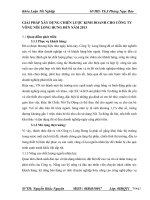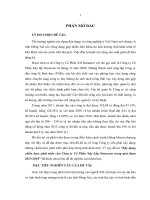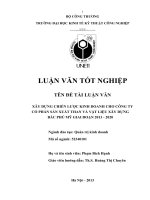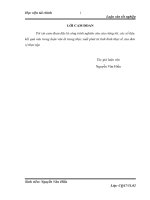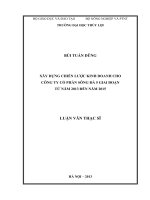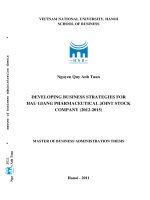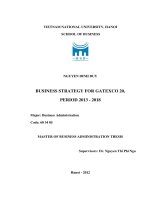Business strategy for GATEXCO 20, period 2013 - 2018 = Xây dựng chiến lược kinh doanh cho công ty cổ phần X20 giai đoạn 2013-2018
Bạn đang xem bản rút gọn của tài liệu. Xem và tải ngay bản đầy đủ của tài liệu tại đây (1.05 MB, 110 trang )
VIETNAM NATIONAL UNIVERSITY, HANOI
SCHOOL OF BUSINESS
NGUYEN DINH DUY
BUSINESS STRATEGY FOR GATEXCO 20,
PERIOD 2013 - 2018
Major: Business Administration
Code: 60 34 05
MASTER OF BUSINESS ADMINISTRATION THESIS
Supervisors: Dr. Nguyen Thi Phi Nga
Hanoi - 2012
ii
ABSTRACT
BUSINESS STRATEGY FOR GATEXCO 20,
PERIOD 2013 - 2018
Nguyen Dinh Duy
MBA candidate, 2008-2010
Viet Nam National University, Ha Noi.
School of Business
Supervisors: Dr. Nguyen Thi Phi Nga
December, 2012, 102 pages
The strategies of the company show the future of the company on doing its
businesses. They analyze the industry segment of which the company is
operating; determine the target market and customers segment for medium
and long term; and the competitive advantages must build up and maintain.
The development of business strategies, however, is a complex task that
requires a lot of attentions from BOD and the company‟s resources.
The research begins with a brief introduction on business strategy
management definition and the process of strategic planning. To develop a
strategic planning complied with sustainability, the company needs to apply
fundamental analysis or namely tool box of strategic planning such as
industry segment analysis, value chain analysis, generic business strategies,
and network success factors and resources analysis. To make all theories
above to be practical, the author will use the case of GATEXCO20 and assess
the current business strategy of the company. The assessment bases on the
iii
results achieved during the interview with managers of GATEXCO20. Then, I
will conduct some conclusions and recommendation.
The author has been working in GATEXCO20 for more than six years and it
is an interesting field that the author loves to work for. With significant
knowledge and experience after the years working as well as the author‟s role
in company, the author does believe that this research would also be a
valuable fundament for the author‟s career development in the years coming.
vi
TABLE OF CONTENTS
ACKNOWLEDGEMENT i
ABSTRACT ii
TÓM TẮT iv
TABLE OF CONTENTS vi
LIST OF FIGURES ix
LIST OF TABLE x
INTRODUCTION 1
A. Background and Rational 1
B. Objectives 2
C. Scope and Limitation 3
CHAPTER 1: FOUNDATION THEORY FOR STRATEGIC
MANAGEMENT 4
1.1. The definition of business strategy 4
1.2. The definition of business strategic planning 4
1.3. The business strategic planning process 5
1.4. Tools used in business strategic planning 8
1.4.1. SWOT matrix 8
1.4.2. Porter‟s Five Forces Model 9
1.4.3. PEST analysis 11
vii
1.4.4. Value chain analysis 13
CHAPTER 2: EXTERNAL AND INTERNAL ANALYSIS 16
2.1. EXTERNAL ANALYSIS 16
2.1.1. PEST Analysis 16
2.1.2. Industry analysis 32
2.1.3. Summary external analysis 38
2.2. INTERNAL ANALYSIS 41
2.2.1. Primary activities 44
2.2.2. Support activities 55
2.2.3. Summary internal analysis 60
CHAPTER 3: SELECTED STRATEGIES FOR GATEXCO 20 AND
INPLEMENTATION PLAN 64
3.1. Choosing functional strategies 64
3.1.1. SWOT analysis 64
3.1.2. GREAT analysis 74
3.2. Performing components of strategy implementation 76
3.2.1. Strategy 77
3.2.2. Systems and structure 77
3.2.3. Style 77
3.2.4. Staff 78
3.2.5. Skills 80
3.3. Action Plans 82
3.3.1. Activities functional strategy 1 - Product quality management 82
viii
3.3.2. Activities functional strategy 2 – Build-up the raw material system 87
3.3.3. Activities functional strategy 3 – Product diversification 88
3.3.4. Action plans for five years strategies 91
3.4. Recommendations to GATEXCO20 for strategies implementation 95
3.5. Recommendations to the Government 97
CONCLUSIONS 98
REFERENCES 100
ix
LIST OF FIGURES
Figure 1: Business strategic planning process – sample 1 6
Figure 2: Business strategic planning process - sample 2 6
Figure 3: Business strategic planning process - sample 3 7
Figure 4: SWOT Matrix 8
Figure 5: Porter's Five Forces Model 9
Figure 6: Value chain analysis model of Porter (1980) 14
Figure 7: Porter‟s five forces model 32
Figure 8: Value chain analysis model 43
Figure 9: The process of receiving input materials 45
Figure 10: The operation process of GATEXCO20 46
Figure 11: Images of some major products of GATEXCO20 48
Figure 12: The distribution system of Viet Tien Garments Company and Nha
Be Garments Company 51
Figure 13: Organization structure of GATEXCO20 54
Figure 14: Five stage of building-up the raw material system 68
Figure 15: 8 key successful factors for TQM 69
Figure 16: Seven-S Framework 76
Figure 17: The business strategy process 96
x
LIST OF TABLE
Table 1: World internet usage and population statistics 2011 30
Table 2: Opportunities and Threats to Gatexco20 39
Table 3: Import and Tariff on Fuels (%) 49
Table 4: GATEXCO20 employees in 2010 and 2011 55
Table 5: Production capacity in 2011 of some garment and textile companies
in the domestic market 58
Table 6: Strengths and Weaknesses of GATEXCO20 60
Table 7: SWOT matrix for functional strategies 64
Table 8: Ranking order of functional strategies 75
Table 9: Trait models by John Gardner (1989) and Zaccaro (2004) 82
Table 10: Six Sigma system 84
Table 11: International trade shows 88
Table 12: Action plans for five years strategies 91
1
INTRODUCTION
A. Background and Rational
Garment and Textile is one of the traditional industries in Vietnam and plays
an important role of the economy development and reducing the
unemployment rate in poverty area. In recent years, Vietnam‟s economic
development has evolved rapidly and has been changing to integrate with
regional and world economies and garment and textile industry is determined
as one of the focused industry of Vietnamese Government that helps the
country to reduce the trade deficits. The evidence for the important of
garment and textile can be found lot of public resources (i.e. newspaper,
television, talk-show, etc) of which these resources stated that garment and
textile industry has contributed a lot in the total GDP as well as creating more
jobs in the economy.
However, the author identifies that the garment and textile industry is facing
many challenges from both of internal and external environment. The internal
problem is rising due to the low skills of major labors and low technology
applied in manufacturing while the external problem is coming from the rush
competition with strong competitors such as China, India, Indonesia,
Pakistan, Korea.
Furthermore, most of the enterprises operating in garment and textile industry
do not take into account the business strategic planning and view it as one of
the vital part on the continuous development. The fact is that every enterprise
needs to apply business strategy that is help to respond quickly to changes in
the market. In each period, the company can adopt one or many strategies
which are based on analyzing and predicting the company‟s strength or
weakness and the market‟s opportunities or threats. The business strategy is
2
built on the basis of analyzing and predicting the opportunities, risks,
strengths and weaknesses of enterprises that help the enterprise obtaining the
general information on external business environment as well as internal
resources of the enterprise. Based on the mentioned problems, they plan the
strategic objectives, select the best strategy and formulate policies to achieve
those objectives and simultaneously inspect and adjust the strategy to face
with the change of business environment. The business strategy helps
enterprises not to fall into a defensive situation, but to always stand on the
offensive side to be ready to face all changes of the business environment.
GATEXCO20 is not the exceptional case in terms of issues related to the
business strategic planning. Currently, GATEXCO20‟s business strategy is
limited to the short term planning without a long term vision. The company
sometimes deals passively with the change in the market and adjusts planning.
Therefore, the need to plan and implement long-term business strategy is very
important and urgent for the survival and development of the company.
Therefore, in the respect of the important role of business strategic planning
for the orientation development of Vietnam‟s garment and textile industry and
the long-term development of GATEXCO20, the author decides to choose
“Business Strategy for GATEXCO20, period 2013 - 2018” as the name of the
research. By driving concentration to the macro-economic factors and the
tools of business strategy formulation, the research will help the top managers
of GATEXCO20 to understand and to adopt comprehensive long term
business strategies to ensure the sustainability in development.
B. Objectives
The objectives of the research are stated as follows:
3
Provide the analyses on the production and business operation of
GATEXCO20 and the potential of Vietnam garment and textile
industry
Find out the advantages, weaknesses, opportunities and threats which
will be used to formulate a development strategy for GATEXCO20
Assess the garment and textile market by collecting the Expert Advises
from The Ministry of Trade and Vietnam Textile Association
Provide the formulation and solution for business strategies for
GATEXCO20 as well as program of action and contingency plans
C. Scope and Limitation
This research examines the activities of GATEXCO20 from the business
strategic planning perspective. The research uses the secondary data which
come from the annual reports of GATEXCO20 as well as collecting from
books, journal and news together with the expert advices from Ministry of
Industry & Trade and Vietnam Textile Association in the internet in terms of
the garment and textile industry which are cited in the reference section.
The limitations of the research are the study just concentrates on
GATEXCO20‟s business. Other limitation relates to data gathering. A lot of
the information was from GATEXCO20‟s sources and data. Moreover, the
study given might not represent the general thinking of company and there are
some language barriers for the author.
The strategy for GATEXCO 20 is built for the period 2013-2018 and if the
implementation process will be success, this strategy will be extended for the
long term.
4
CHAPTER 1: FOUNDATION THEORY FOR STRATEGIC
MANAGEMENT
1.1. The definition of business strategy
Rumelt (1980) defined business strategy as the combination of goals, objectives,
missions and action plans in order to help the firm to run its businesses
successfully. Quinn (1998) defined business strategy as the plan in order to
integrate all business activities and to align them with the goals, objectives of
development of firm. Mathur and Kenyon (1997) identified that when firm
provides its products and services in multiple, it will have a number of different
business strategy, so each business strategy has the different scope of work and
application. Favaro (2012), in addition, defined business strategy as a result of
selection in order to maximize firm‟s values for long term. However, Favaro
(2012) advised firm management should takes into account the value in short term
as well as risk factors existed in the market.
1.2. The definition of business strategic planning
Strategic Planning Handbook (2001) stated that strategic planning Is
described as a road map which is designed to help firm reaching to
expectations. Tapinos (2005) defined business strategic planning is the
combination of importance steps that helps firm to formulate business
strategies. When performing business strategic planning, Tapinos suggested
that firm should takes into consideration of four factors: long horizon,
utilization of planning tools, formality, and frequent monitoring the planning
process. Hodgetts and Kuratko (2001) addressed the importance of business
strategic planning as it can reduce significantly the uncertainty or the failure
of a business strategy. Gibb and Scoot (1985), business strategic planning also
helps to increase the perception and awareness of the importance of business
5
strategy in the executive managers‟ mind as well as in the employees.
However, business strategic planning also has a lot of risks. First, the road
map may not bring the right expectation to firm as the result of the changes in
the market and customers behaviors. Second, the success of business strategic
planning is depended on the planning process. If the planning process is weak
(e.g. lack of control and monitor), the achieved results may not satisfactory to
firm‟s executive managers. (Strategic Planning Handbook, 2001)
Additionally, Evans identified that the business strategic planning just focuses
on the most significant issues and does not take into account all critical issues
of firm. The reason, as Evans stated, is the business strategic planning is
managed by the upper management level and they do not have time to
examine everything in detail. Furthermore, business strategic planning is very
time consuming and requires the involvement of people. All of this can drain
the organization, especially if resources are scarce.
1.3. The business strategic planning process
Grunig (2011) proposed a business strategic planning with seven steps. The
first step is strategic is analyzed where all the analyses are carried out such as
SWOT analysis, Porter Five Forces Model analysis, internal matrix
evaluation, external matrix evaluation. This step helps the enterprise
determines the combination between the opportunities, risks of external
business environment with the strengths and weaknesses of enterprise to
establish the combination that is a basis of business strategy planning. Then,
the company provides the statement for business mission. The third and fourth
steps are the company selects the business and corporate strategies based on
the analyses in the first and second steps. The fifth step is the business
strategies implementation. Then, the sixth step where the business strategies
6
are put in the frequent reviews. The last step is the strategic document are
prepared and approved by the board of management.
Figure 1: Business strategic planning process – sample 1
(Source: Grunig, 2011)
Chetthamrongchai (2009) provided the business strategic planning process
that takes into consideration seven steps, including: business mission, SWOT
analysis, goal formulation, strategy formulation, program formulation,
implementation, and feedbacks.
Figure 2: Business strategic planning process - sample 2
(Source: Chetthamrongchai, 2009)
7
Hax (2003) stated that business strategic planning process includes five steps:
The missions of businesses, Internal and external environment analyses,
Business strategy formulation, Strategic programming, and Budgeting.
Strategic Planning Handbook (2001) stated that the business strategic
planning process needs to have the separate steps for mission statement,
objective creation, goal determination and action plan.
Figure 3: Business strategic planning process - sample 3
(Source: Hax, 2003)
8
1.4. Tools used in business strategic planning
1.4.1. SWOT matrix
Bradford et al (2000) states that the SWOT matrix can be used to formulate
the business strategies based on both of internal and external environment
affection to a enterprises. While the Strength (S) and Weakness (W) represent
for the internal ability of the enterprises, the Opportunity (O) and Threat (T)
represent for the external environment affection to the enterprises. Chaffey et
al (2006) stated that SWOT analysis helps the company evaluating it strengths
and weaknesses in the context of opportunities and threats in the market. The
figure below shows the SWOT matrix and the strategies which are formulated
based on four factors: strengths, weakness, opportunities and threats.
SWOT ANALYSIS
EXTERNAL
OPPORTUNITIES
EXTERNAL
THREATS
INTERNAL
STRENGTHS
How can our strengths
be employed to take
advantage of our
opportunities?
How can our strengths
be used to prevent
threats from hindering
goal achievement?
INTERNAL
WEAKNESSES
What should we do to
shore up our
weaknesses to take
advantage of our
opportunities?
What should we do to
shore up our weakness
to prevent the threats
from slowing us down?
Figure 4: SWOT Matrix
(Source: Adopted from Bradford et al, 2000)
9
1.4.2. Porter’s Five Forces Model
The model of Five Forces of an industry was provided by Porter in 1980. This
model includes five distinct entities, including the power of buyers, the power
of suppliers, the substitute products, the threat of new entrants and the rivalry
between competitors in the industry. Ehnke, Fulton, Akridge, Erickson and
Linton (2004) highlighted the importance of Porter‟s Five Forces Model as it
helps firm to determine the potential profit of an industry which firm is
operating in, and helps firm to answer the question of what the key successful
factor for competitive advantage.
Figure 5: Porter's Five Forces Model
(Source: Porter, 1980)
1.4.2.1. Power of suppliers
The suppliers are more powerful when firm has to purchase the raw materials
necessarily for manufacturing products from the small number of suppliers.
10
On the other hand, it means that there are not so many suppliers in the
industry and the suppliers has the power of determining the prices and
quantity of selling raw materials for firms in this industry.
In addition, the buyers are also powerful in case of firms face very high costs
of switching suppliers. Or the raw materials‟ purchasing amount of firm is
low and the suppliers have more power of controlling purchasing prices. The
power of buyers is more increasing in non-transparency market or firms do
not have adequate knowledge of the supplier market. (Ehnke, Fulton,
Akridge, Erickson and Linton, 2004)
1.4.2.2. Power of buyers
The buyers are more powerful when the buyers have high knowledge in the
industry and they understand deeply the business process of firm, thus firm
does not have high power of negotiation with the buyers. The second reason
for the power of buyers is that the industry is covered by a lot of suppliers and
the customers can find easily the alternative suppliers or alternative products
to feed their demands.
1.4.2.3. Substitute products
Substitute products are more important to firms in case firms‟ products are not
distinguished to other products. Ehnke (2004) stated that firms who are
following the low cost strategy will face more threat form substitute products
than firms who are following the differentiation strategy. Additionally, other
reasons for higher threat of substituted products are customers have less brand
loyalty or the cost of product switching is very low to the customers.
11
1.4.2.4. Threats of new entrants
The new entrants are becoming real threats for firms in the industry when the
business law encourages the new entrants to enter the market without barriers.
Or, the customers are not loyalty to the products and sergices‟ brands. It
means that the customers can be switch to other products and services without
taking consideration of the current brands they are using. The threats of new
entrants are more increasing when the production process is not difficult to
duplicate and economy of scale is low. In more detail about the economy of
scale, the economy of scale impacts on the production process of firms. If
firms produces products in large volumes but they do not gain so much values
from the economy of scale (e.g. lower cost), they will face the high
competition from new entrants in the market. (Ehnke, Fulton, Akridge,
Erickson and Linton, 2004)
1.4.2.5. Rivalry among competitors
High rivalry among competitors is often found in slow growth market where
firms have to utilize the economy of scale to control the operating cost and to
reduce the products and services‟ prices offered to the customers. Other
reason of high rivalry among competitors is that the product of firm is not
differentiating to product of other firms. It means that other firms can
duplicate the firm‟s products and services easily. Additionally, the high
rivalry among competitors can be explained as the result of high cost for
exiting the industry.
1.4.3. PEST analysis
PEST analysis is provided by Doole and Lowe (2008) that is considered as
the important tools for firms to analyze the impacts of external environments.
PEST analysis takes into consideration of four aspects of external
12
environment: political environment, economy environment, social
environment, and technology environment.
Political environment takes into account the political risks in a country or in
the globe that impact directly to firms‟ activities. Doole and Lowe (2008)
refers politics to the behavior and actions of the local government or the
internal bodies (e.g. World Trade Organization, World Bank, International
Monetary Fund) toward establishment of the business environment and legal
framework for the operation of firms. Normally, the business legal framework
in developing and emerging markets is not comprehensive as in the developed
markets. On the other hand, the local governments in developed countries
have more expertise compared to local governments in developing and
emerging markets, thus they can formulate better policies or better vision of
establishing policies and legal that support fair competition in the markets.
Economy environment refers to the macro and micro economic factors that
affect directly or indirectly to firms‟ businesses. For example, the imbalance
in the macro economy (e.g. high inflation rate and high lending interest rate)
impacts directly to the purchasing power of the people in the country, thus
impacting directly to pricing strategy of firms. In more detail, if the inflation
rate is high, the operating cost of firms also increases and firms have to
increase the products‟ prices. However, when firms increase the products‟
prices, they may lose the customers and market share to other firms who have
lower pricing for products and services.
Social environment is defined as the changes in the society as the results of
the growth and movement of population within a country or in the globe
(Doole and Lowe, 2008). Previous studies denote the new trend of social
environment that the products and services of firms should be aligned with the
13
urban style. In more detail, the products and services of firms should be
packaged conveniently and easy to carry. The customers today is more
accessible and can be communicated through supermarket, mall and mass
media (e.g. television and online advertisements).
Technology environment is the application of information technology and
equipments in order to support the businesses of firms and to provide the most
convenient way to customers in purchasing firms‟ products and services
(Doole and Lowe, 2008). In the world today, the uses of computer-based
technologies are not only being more and more increased in developed
countries but also in emerging and developing countries. The use of high
information technology is one of the critical success factors in multi-national
companies who have to develop the comprehensive information technology
solutions for deriving the business decisions in time (SAS, 2012).
1.4.4. Value chain analysis
In 1980, Michael Porter provided the value chain analysis that is often uses to
derive the appropriate business strategies for firms. This analysis is carried on
the two important aspects of firms: primary activities and support activities.
Primary activities include inbound logistics, operation, outbound logistics,
marketing and sales, and service. Support activities include firm
infrastructure, human resource management, technology development, and
procurement. Gregorio () defined primary activity is the process of purchasing
necessary raw materials, manufacturing products and sale to the customers.
This activity also includes the after sale services and customer care; and
defined support activity as those that merely supports the primary activity.
14
Figure 6: Value chain analysis model of Porter (1980)
(Source: Porter, 1980)
Porter (1980) also highlighted the importance of linkage between primary
activities and support activities. On the other hand, it means that primary
activities and support activities are linked with each other and one activity in
the value chain can impact to other activities. For example, the procurement
process can affect to the inbound logistics. If the firm does not purchase the
assets in time, the firm cannot have sufficient resources for its operation and
thus the firm cannot meet the customers‟ commitment and loosing the market
share to other firms who have better procurement process. Porter (1980) also
addressed the challenge of which the firm often may not anticipate well the
synchronization level between activities in its value chain. The bad
anticipation is due by the weak of management board or the high fluctuation
in the market and customers‟ demands.
Value chain analysis is more important in case of firms who derive their
operations in low cost strategies. Value chain analysis helps firms to evaluate
the current performance of overall internal activities and identify which parts
15
in the value chain are not supportive their low cost strategy and thus
providing the necessary restructuring actions.
Value chain analysis is also important aspect that helps firm who are
conducting the differentiation strategy. In this context, Porter (1980) suggests
firms conducting the forward integration between activities in the value chain.
The forward integration means that linkages of the activities are based on the
customers‟ demands.
Porter (1980) suggests firms should allocate costs based on their activities in
the value chain and the costs should be categorized into ten drivers:
Economic of scale
Learning cost
Capacity utilization
Linkage among business activities
Horizon interrelationship between business units within primary and
support activities
Vertical interrelation between primary activities and support activities
Time to entry the market
The internal policy of the firms toward cost allocation and management
Geographic location
Legal factors such as business law of a country, GDP, inflation, total retail
consumption
16
CHAPTER 2: EXTERNAL AND INTERNAL ANALYSIS
2.1. EXTERNAL ANALYSIS
2.1.1. PEST Analysis
Vietnam is one of the most competitive garment and textile exporting
countries in the Asia and the world today. The buyers from other countries
supply the materials for processing and manufacturing to Vietnamese garment
and textile enterprises, then they buy the processed goods back for re-
exporting after labeling their brand names. Vietnam now is determined as the
country has the competitive advantage in garment and textile exporting due to
the Vietnamese labors have high skills but inexpensive labor cost.
It is very clearly to say the macro-economy and policies are always affecting
to the garment and textile industry. For example, Agglomeration of garment
and textile manufacturing has developed very well after the opening up of its
economy since the Doi Moi policy since 1986. Furthermore, with the
encouragement policies of the Vietnamese Government of which allowing the
development of new enterprises for manufacturing and exporting, there are
more and more garment and textile companies have been established and they
have been contributing a lot into the Vietnam‟s GDP recently.
In the next section, the author examines the key economic indicators of
Vietnamese macro-economy as well as identifying the retail consumption
volume, social and political environment. These analyses are closed to the
PEST analysis theory developed by Isobel Doole, Robin Lowe, (2008)
1
of
which, the PEST analysis will be conducted by examining the four factors:
social environment, legal, politics, economy situation and technology
availability.
1
Isobel Doole, Robin Lowe, (2008). International marketing strategy: Analysis, Development and
Implementation, 5th Edition, Cengage Learning EMEA, pp7-17
17
Political environment
Political risk is defined as a risk due to a sudden or gradual change in a local
political environment that is disadvantageous or counter-productive to foreign
enterprise and markets.
Politics refer to a government‟s attitude to business and the freedom level for
the enterprise to operate within. Unstable political regimes bring both of
opportunities and threats for the company and effect on international strategy
of the company. It is clear to say that the emerging countries have higher
political risk than developed countries. The stringency of economic reforms in
those countries can itself lead to civil disorder and increasing oppositions to
governments as has seen in Brazil and Argentina.
Economy environment
The economic conditions will also affect to the business strategies of the
enterprise when there are divergent levels of economic development. Such
different incomes often make an challenge for the enterprise to have
consistent strategy, especially in pricing. This challenge can be easily to see in
developed economies, less developed economies and emerging economies.
In the emerging markets, there is a huge of growing demand for everything
from automobiles to furniture. We can identify the participation of
government in economic reforms, lowering of restriction on foreign
investment and increasing privatization of state-owned monopolies. All these
factors above bring significant opportunities for any enterprises.
Social environment
In the social environment, Isobel Doole, Robin Lowe, (2008) have revealed
the important of growth and movement in population around the world,
leading to the social changes. Isobel Doole, Robin Lowe, (2008) pointed to
the statistical figures which showed that 80% of world‟s population lives in
